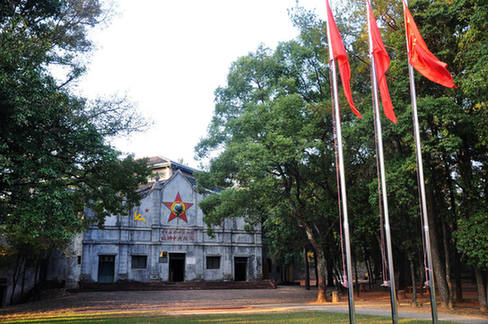| Ruijin Rides Red Nostalgia
By staff reporter ZHAO YAYUAN
BEIJING became the capital of the People’s Republic of China in 1949, but Ruijin was the original heart of communist rule in China. This city of Jiangxi Province, 1,991 kilometers south of Beijing, was once the capital of the Chinese Soviet Republic, as established by the Communist Party of China in 1931. Today, Ruijin is called the “red capital,” and referred to as the “cradle of the People’s Republic.” It was the starting point of the Long March and is now the destination of “Red Tours.”
 |
|
Memories are made of this – site of the Second National Congress of Workers, Peasants and Soldiers of the Chinese Soviet Republic in Shazhouba Town is one of the 180 such sites in Ruijin. |
Cradle of the Republic
Red is a color you’d associate specifically with Ruijin. As soon as you enter the city you notice that the main road is lined with red flags. A careful observer will find the flag of the Chinese Soviet Republic takes its place among the five-starred national flags.
On November 7, 1931, the First National Congress of Workers, Peasants and Soldiers of the Chinese Soviet Republic was sponsored by the Communist Party of China (CPC) at the Xie Clan’s Ancestral Temple in Yeping Village, Ruijin. The first regime set up by the CPC – the Temporary Central Government of the Chinese Soviet Republic – was established right here. Ruijin was made the capital, renamed Ruijing, and it was at this conference that the resolution on the Constitution Outline of the Chinese Soviet Republic and other resolutions were adopted.
Shazhouba Town of Ruijin was the site of the Second National Congress of the Chinese Soviet Republic, convened in January 1934. At that time, the Political Bureau of the Central Committee of the Communist Party had moved from Shanghai to Ruijin, so the word “temporary” was dropped from “Temporary Central Government.” Here the outline for the constitution was revised and the resolutions on a national flag, national emblem and military flag were adopted.
There was a period of nearly six years – from February 1929 when the Red Army moved from the Jinggang Mountains to southern Jiangxi, to the start of the Long March in October 1934 – when the Communist Party of China ruled the Central Soviet Area from Ruijin, gaining its first experience with governance. Most of the early political and military leaders of the Communist Party were veterans from Ruijin. Liu Yang, deputy director of the Administrative Office of the Ruijin CPC Revolutionary Base Area Museum and Exhibition Halls, told China Today: “The importance of Ruijin lies in the fact that the Communist Party of China first attempts to settle affairs of state, in fields such as legislation, taxation and education. Almost all the existing central organs of state, ministries and commissions find their predecessors in Ruijin.”
The people of Ruijin made great contributions to the victory of the Chinese revolution, and also made great sacrifices. At that time, Ruijin had a population of 240,000. Some 113,000 people joined the Red Army; 50,000 of them died for the revolution, including 10,800 perished on the Long March. The historical records list 17,166 martyrs. To support the construction of the Soviet Area and the Red Army’s Long March, between 1932 and 1934 the people of Ruijin purchased 780,000 yuan of government bonds, lent 12,500 tons of grain, and donated 220,000 taels of silver. Their savings of 26 million silver dollars deposited in the Soviet State Bank during the Long March were used to support the revolution.
Ruijin’s economic development was not smooth however. After the founding of the People’s Republic in 1949, it found itself restricted by multiple factors such as transportation, resources and funds. Before Ruijin was promoted from a county to a city in 1994, it was classified as a national-level poverty zone.
|
